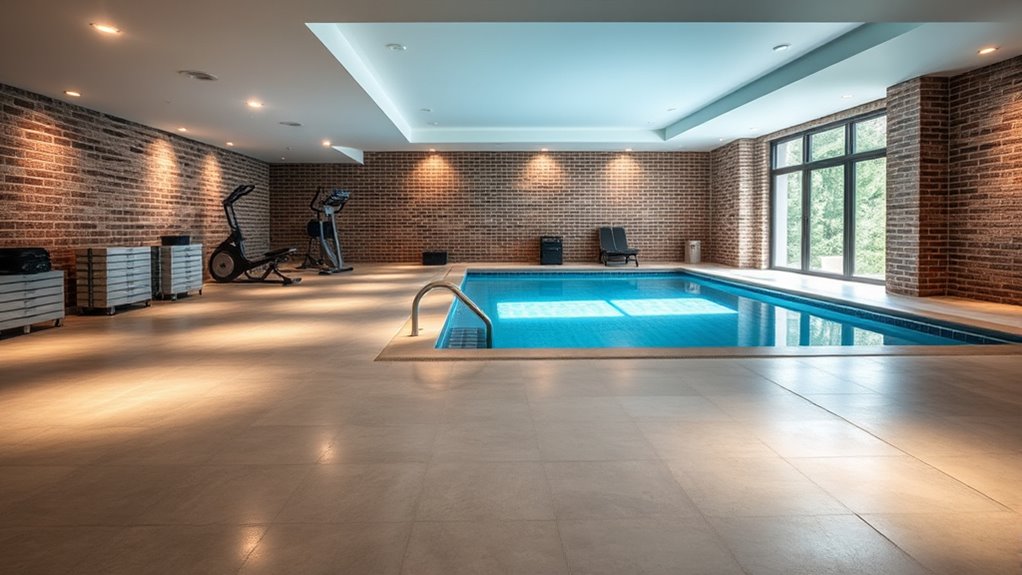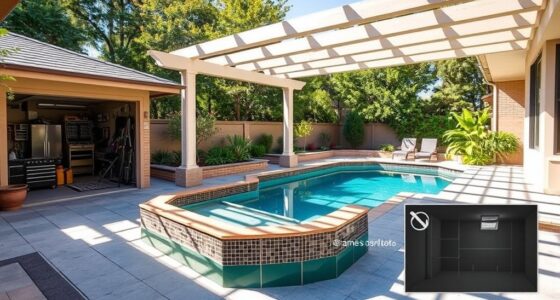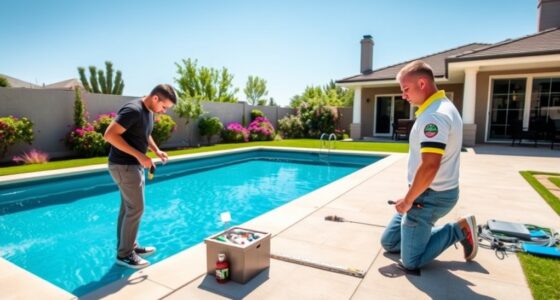When choosing between a basement or garage for your endless pool, consider space, accessibility, and structural support. A basement offers more privacy and better insulation but needs reinforcement and proper sealing. A garage provides easier access but might require insulation, ventilation, and moisture control to prevent environmental damage. Think about noise levels and convenience for daily use. Continue exploring to discover the key factors that will help you pick the best spot for your pool.
Key Takeaways
- Assess structural support and foundation strength to safely accommodate the pool’s weight and water volume.
- Consider accessibility for maintenance, daily use, and equipment transportation between the space and main living areas.
- Evaluate environmental factors like moisture, wind, and insulation needs to ensure long-term durability.
- Check electrical and plumbing requirements to ensure proper installation and compliance with safety codes.
- Prioritize privacy, noise insulation, and minimal disruption to optimize the pool’s enjoyment and integration into your home.
Assessing Space and Layout Considerations
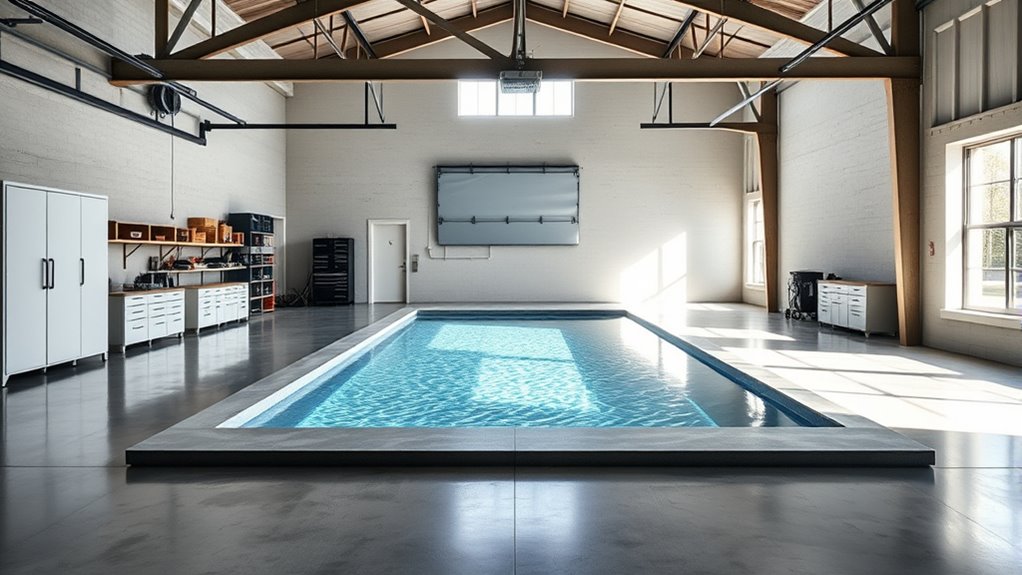
When evaluating whether to convert your basement or garage, the first step is to carefully assess the available space and layout. Measure the dimensions of each area, noting any obstructions like support beams, pipes, or electrical panels. Consider the ceiling height; an endless pool requires ample vertical space for installation and use. Check for structural elements that could limit your options, such as load-bearing walls or uneven floors. Think about doorways, staircases, and pathways that could impact access or movement around the pool. Visualize how the space flows and whether it can accommodate necessary equipment and accessories. Ensuring the area is spacious enough and has a suitable layout prevents future surprises and helps you decide whether your basement or garage is the better fit for your endless pool project. Additionally, assessing the space for collaboration and potential for future modifications can make a difference in your decision-making process.
Evaluating Accessibility and Convenience
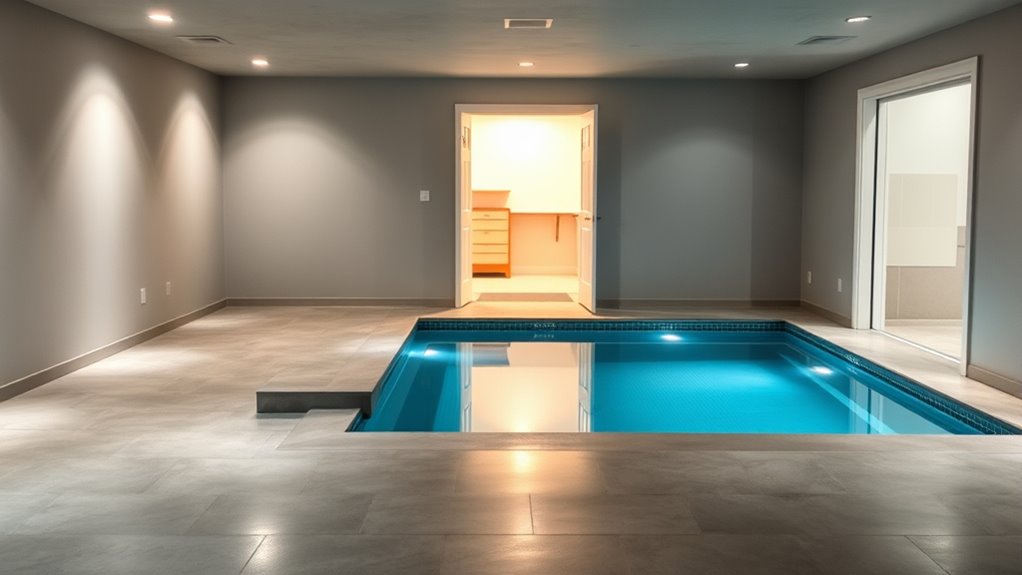
Accessibility and convenience play a crucial role in choosing between your basement or garage for an endless pool. Consider how easily you can access the space daily, especially when transporting equipment or cleaning. Think about proximity to your main living areas for quick use. To compare options, evaluate these factors:
| Factor | Basement | Garage |
|---|---|---|
| Entry Ease | Stairs or elevator needed | Direct garage door access |
| Path Clarity | Clear, unobstructed pathways | Limited space, possible clutter |
| Proximity to Home | Usually closer to main areas | Can be farther from living spaces |
| Storage & Equipment | Dedicated space for accessories | May need to reorganize garage |
Additionally, considering the ease of maintenance and how it impacts your routine can help determine the best spot. Prioritize what makes daily use seamless and hassle-free.
Addressing Insulation and Temperature Control
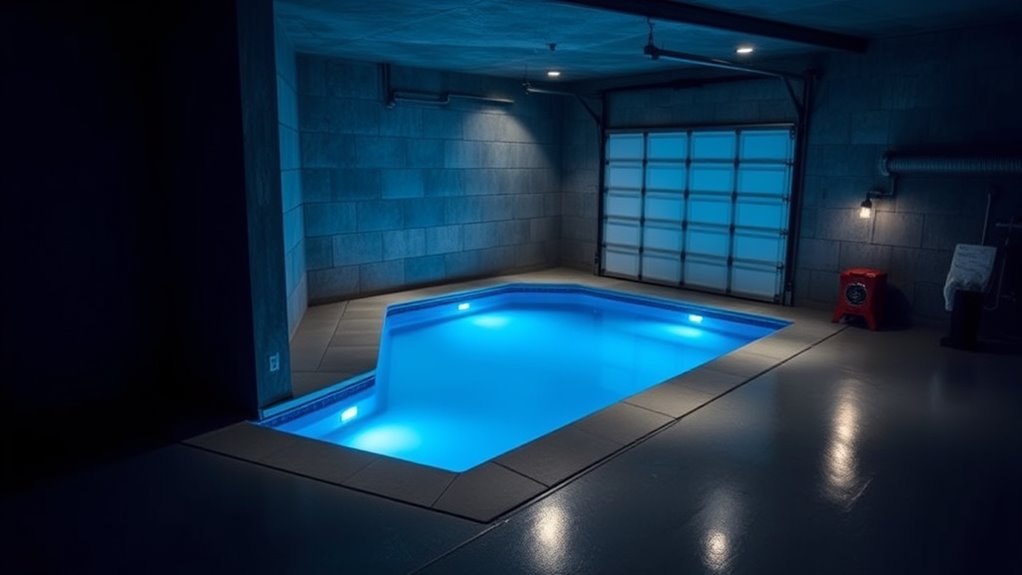
Have you considered how insulation and temperature control impact your endless pool’s comfort year-round? Proper insulation keeps the water warm in winter and cool in summer, making every swim enjoyable. Without it, you might face:
Proper insulation and temperature control ensure your pool stays comfortable year-round.
- Unexpected chills that ruin your workout or relaxation.
- Higher energy bills due to constant heating or cooling efforts.
- Cold drafts that make your pool area uncomfortable.
- Frustration from inconsistent water temperatures, disrupting your routine.
Investing in quality insulation and a good temperature control system ensures your pool remains inviting regardless of weather. It creates a cozy oasis right in your home, turning your pool into a year-round retreat. Don’t let temperature fluctuations keep you from enjoying your endless pool whenever you want.
Ensuring Proper Ventilation and Moisture Management

Proper ventilation is key to keeping your basement or garage dry and fresh. You should implement effective strategies like exhaust fans or vents to promote airflow and reduce humidity. Additionally, using moisture control techniques, such as dehumidifiers and sealing leaks, helps prevent mold and water damage. Paying attention to air circulation can further improve overall ventilation efficiency.
Adequate Ventilation Strategies
Effective ventilation is essential for preventing moisture buildup and maintaining a healthy environment in your basement or garage. Without proper airflow, humidity can cause mold, unpleasant odors, and structural damage. To guarantee your space stays fresh and dry, consider these strategies:
- Install exhaust fans to remove stale air and excess moisture quickly.
- Use vent windows or air vents to promote natural airflow during favorable weather.
- Incorporate dehumidifiers to actively control humidity levels.
- Keep vents clear of obstructions to maximize airflow and prevent dampness.
These steps create a protective barrier against moisture problems, giving you peace of mind. Proper ventilation not only safeguards your investment but also ensures a safe, comfortable space for your endless pool.
Moisture Control Techniques
To keep moisture levels in check and prevent damage, you need to actively implement moisture control techniques that complement your ventilation efforts. Start by using dehumidifiers to remove excess humidity, especially in humid climates. Ensure your space has proper insulation to prevent condensation on walls and ceilings. Seal any gaps or cracks that let in moist air from outside, and install vapor barriers on floors and walls to reduce moisture seepage. Regularly check for leaks or water intrusion and address them promptly. Use exhaust fans in areas prone to humidity, like bathrooms or laundry zones, to help circulate moist air outside. By combining these techniques with good ventilation, you’ll create a dry, stable environment that protects your endless pool and prolongs the lifespan of your space.
Analyzing Structural Support and Foundation Needs

You need to assess whether your foundation can support the added weight of your planned space. Check the load capacity to make sure it’s sufficient, and identify if any reinforcement is necessary. Proper structural support guarantees safety and long-term stability for your basement or garage. Additionally, understanding the signs of structural weakness can help you identify potential issues before they become serious.
Foundation Load Capacity
Have you ever considered how much weight your basement or garage foundation must support? The load capacity determines whether your space can safely hold an endless pool. If the foundation isn’t strong enough, you risk structural damage or failure. To ensure safety, consider these critical factors:
- The pool’s filled weight, which can reach thousands of pounds
- The weight of water displaced during use
- Additional equipment like filters and heaters
- The dynamic forces from active swimming or movement
- Developing an awareness of your creative practice can help you better plan for challenges and solutions in your project.
Understanding these loads helps you assess if your current foundation can handle the extra weight. If not, reinforcement or a different location might be necessary to keep your dream pool safe and secure. Never underestimate the importance of a solid foundation.
Structural Reinforcement Requirements
Determining whether your existing foundation can support a pool requires examining its structural support and reinforcement needs. You need to assess if your floor can handle the weight of the filled pool, which can reach thousands of pounds. If your garage or basement isn’t originally designed for such loads, reinforcement is necessary. You may need to add steel supports, thicker concrete slabs, or additional framing to distribute the weight evenly. You should also evaluate any existing structural elements for weaknesses or cracks. Consulting with a structural engineer is vital to identify specific reinforcement requirements and guarantee safety. Proper reinforcement prevents future damage, sagging, or collapse, giving you peace of mind that your pool installation is secure and long-lasting. Additionally, understanding the underlying beach environment and potential for environmental factors like wind or moisture can influence the choice of location and reinforcement strategies.
Considering Privacy and Noise Levels
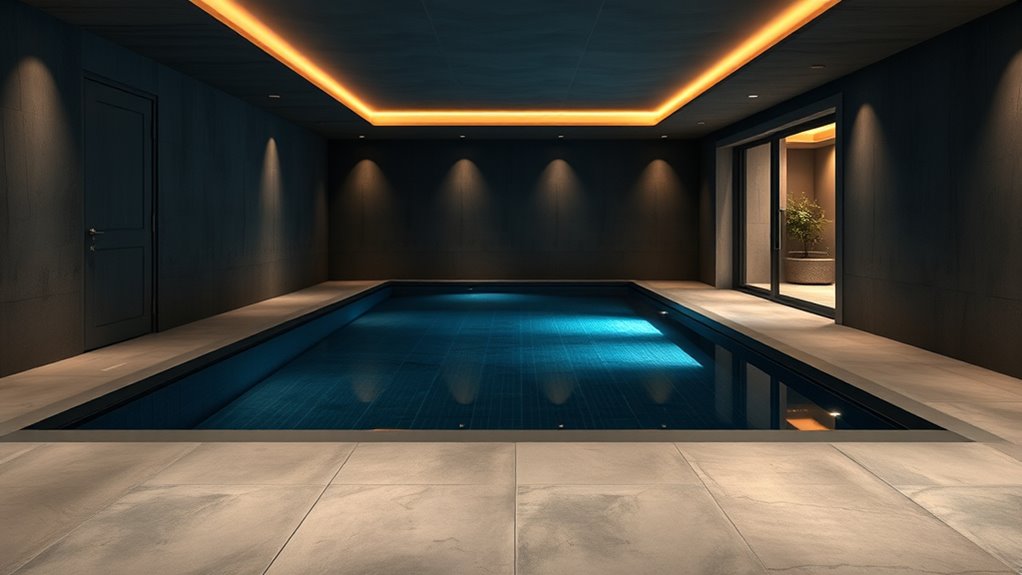
When choosing between a basement or garage for your needs, considering privacy and noise levels is essential. Your pool area should be a retreat, not a source of constant disturbance. Think about:
Choosing the right space ensures your pool remains a private, peaceful retreat free from noise disturbances.
- Privacy from neighbors—a secluded spot helps you relax without prying eyes.
- Noise insulation—prevent splashes and pool noises from echoing into living spaces.
- Disruption to family routines—avoid locations where pool sounds could disturb others.
- Personal comfort—a private, quiet environment makes your swim sessions more enjoyable.
- Incorporating soundproofing techniques can further enhance privacy and reduce noise transmission.
Planning for Electrical and Plumbing Requirements
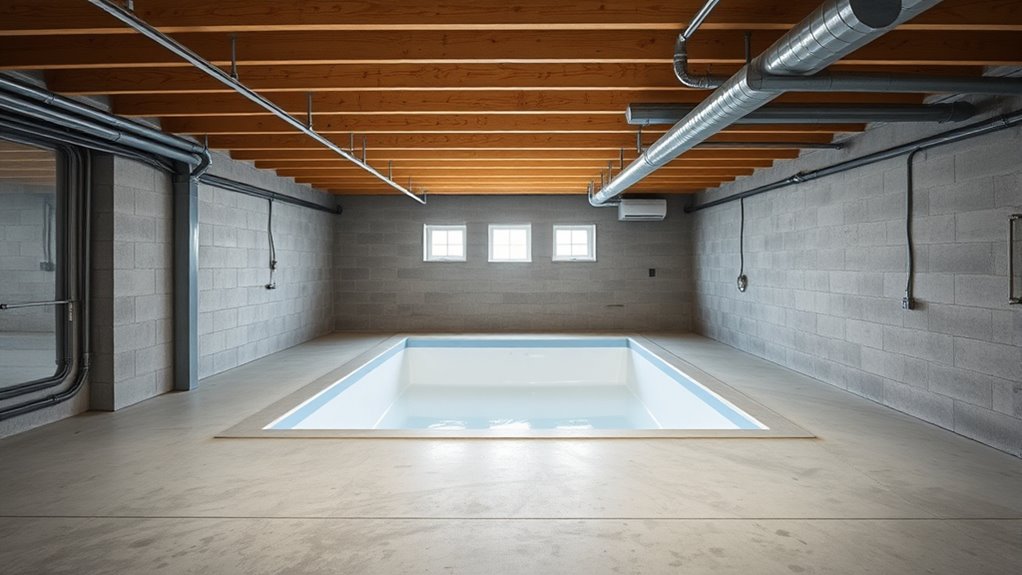
Planning for electrical and plumbing requirements is a critical step to guarantee your pool functions safely and efficiently. You need to ensure there’s adequate power supply and proper wiring to handle the pool’s equipment, including pumps, heaters, and lighting. Consult a licensed electrician early to determine if your existing circuits can support the load or if upgrades are necessary. For plumbing, plan for water supply lines and drainage to manage inflow and waste removal effectively. Check local building codes and permits to avoid violations. Proper placement of electrical outlets and plumbing fixtures is essential to prevent leaks, electrical hazards, and ensure easy maintenance. Additionally, understanding the importance of fathers’ guidance can help you create a safe and well-designed space. Taking these steps ahead of time saves you headaches and guarantees a smooth installation process.
Frequently Asked Questions
What Is the Typical Cost Difference Between Basement and Garage Installations?
The cost difference between basement and garage installations generally ranges from $2,000 to $5,000, with basement setups often being more expensive. Basement preparations may require waterproofing and reinforced flooring, adding to costs. Garages usually involve simpler access and less structural modification. Your choice affects installation expenses, so consider your budget, access, and space needs to make the best decision for your endless pool.
How Long Does Installation Usually Take in Each Location?
Installation typically takes about one to two weeks for either location, but it can feel like a lifetime if delays happen. In your basement, it might be slightly faster because of easier access and fewer weather-related issues. In the garage, you might face more prep work and structural adjustments, stretching the timeline. Be prepared for some variability, and plan accordingly to enjoy your endless pool sooner.
Are There Specific Building Codes I Should Consider?
Yes, you should check local building codes and permits before installing your endless pool. These regulations might cover electrical wiring, drainage, ventilation, and safety requirements. Contact your city or county building department to guarantee compliance. Hiring a professional installer can also help you navigate these codes smoothly, avoiding fines or delays. Staying informed and adhering to local rules guarantees a safe, legal, and hassle-free installation process.
Can I Add Features Like Waterfalls or Lighting Easily?
Yes, you can easily add features like waterfalls or lighting to your Endless Pool. Most systems are designed for customization, allowing you to install lighting fixtures, water features, and jets with relative ease. Just guarantee your electrical wiring and plumbing meet safety standards, and consider consulting a professional for complex installations. This way, you’ll create a personalized, relaxing environment that enhances your pool experience.
What Maintenance Challenges Are Unique to Each Setting?
Did you know that water quality issues can increase by 20% in enclosed spaces? In a basement, you might face humidity and mold risks, making regular dehumidification essential. A garage, on the other hand, exposes your pool to temperature swings and dirt, requiring frequent cleaning and filtration. Both settings demand diligent maintenance, but your choice impacts how often you’ll need to address issues like humidity control or debris removal.
Conclusion
Choosing between your basement and garage for your endless pool depends on careful planning and your specific needs. Consider space, accessibility, insulation, ventilation, and structural support to guarantee a safe and enjoyable experience. Remember, “A stitch in time saves nine”—address issues early to avoid costly repairs later. With the right preparation, you’ll create a perfect aquatic retreat right at home, turning your space into a relaxing oasis whenever you need it.
